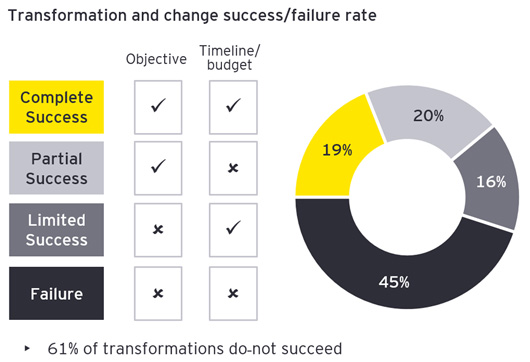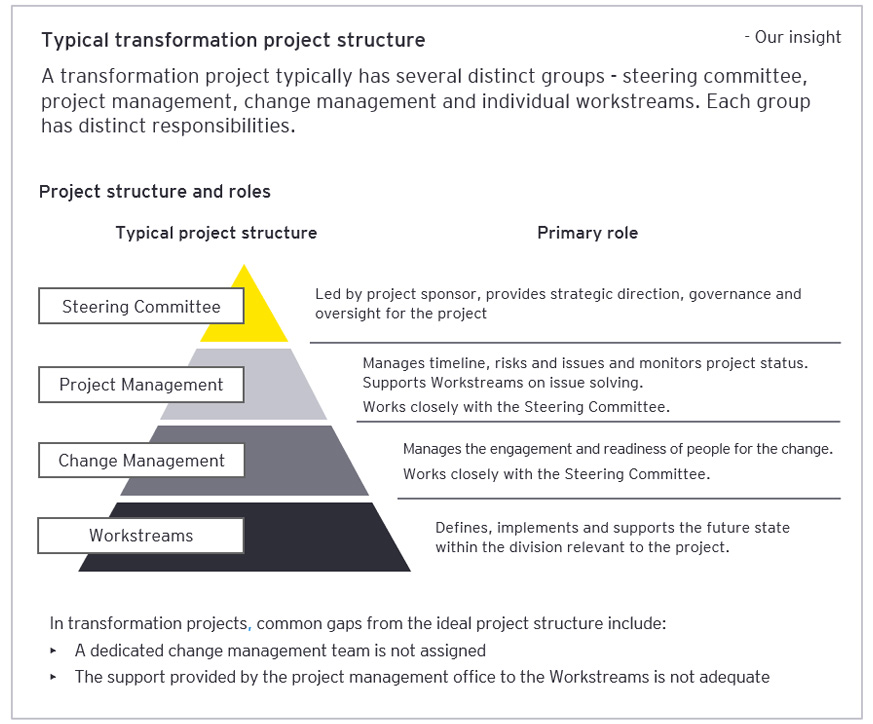1. Survey Overview
Businesses in Japan find themselves at a pivotal inflection point. Economic and social changes are motivating companies to accelerate their business transformations. But navigating change is not easy, and leaders seek information about how change is successfully implemented in Japan.
To support this need, EY with advice from Professor Koide from Sanno University, conducted a study to identify key success factors for transformations. More than 250 companies participated in the study, sharing Japan-specific transformation information for changes of differing scope and size (entire group company, subsidiary, function or division).
The findings reflect that transformations are becoming more complex and key to increasing transformation success and accelerate adoption is to have dedicated change management resources and activities.
2. Transformation trends in Japan
There are many reasons companies are transforming. The most common objectives of transformations launched in the past 5-7 years, according to the study, were core business expansion (65%), followed by business efficiency (59%). The most challenging types of transformations involved a significant change in business strategy (33%) and cross-functional transformation (27%).
Looking forward, transformation objectives are shifting from core business expansion and business efficiency improvements, to significant business strategy changes (78%) and cross-functional transformations (76%), both of which tend to be larger and more complex.
It is commonly understood that change is difficult, and this study confirms it. Only 19% of transformations were completely successful; success defined as achieving the project’s objective, timeline and budget. 45% of transformations failed to meet any success criteria.

3. Key factors for a successful transformation
The greater the number of change management activities executed as part of the transformation, the higher the success rate. What type of change management activities and what type of project structures led to greater success? Influencing factors included the project structure, leadership, engaged employees and ownership of change management.
3.1 Project structure

There is no consistency in which group or function is responsible for change management activities in a transformation. Corporate planning (61%), the project team (54%) and the impacted function (62%) were chosen most often as responsible for change management work. However, the transformation success rate does not differ significantly by group or function responsible. Regardless of the group responsible, the success factor is creating a structure with clear roles and responsibilities and ensuring there is a dedicated focus on change management.
3.2 Leadership
The strength of the leadership before a transformation begins also influences the ability of a business to adapt to the change. Survey participants were asked to choose organizational elements they felt contributed to the transformation’s success. The most frequently selected answers included having a clearly articulated corporate vision and strategy, alignment of executives and middle-management, and a strong culture of collaboration and cooperation across functions. These factors help increase trust in leadership which can contribute to trust in the transformation.
3.3 Engaged employees
In addition to the factors mentioned above, having engaged employees is a key factor in accelerating adoption of the change. Successful transformations reported having supportive employees 63% of the time while failure cases reported having supportive employees only 30% of the time. Further, companies that focused on change management efforts had supportive employees 19 percentage points more often than those that did not. There were specific change management activities that were found to contribute to engaging employees.

The change management activities that increased employee support for the transformation and accelerated change adoption included: frequently communicating with employees about the transformation; clearly defining the transformation's vision, goals and benefits; securing adequate resources; and involving middle-managers in the transformation from the beginning. Planning and executing these activities take focus and time, which are often underestimated in the project team planning.
3.4 Ownership of change management
The study found that the group or function responsible for change management activities varies, but the important correlation was that change management responsibilities be clearly defined and addressed upfront in the planning stage and throughout the entire project and ownership for change management activities be assigned.
4. Conclusion
Transformation success is measured by the achievement of the objectives, timeline and budget upon launch. However, this is not indicative of a transformation’s long-term sustainability. Our experience is that long-term sustainability can only be achieved if there is strong engagement at all levels of the organization. With anticipated transformations being more complex and challenging, having dedicated change management resources and capabilities in Japan are more important than ever if the transformation is to be successful.
Note: Survey results addressing the role of HR in change management will be covered in a future article.
Click here to refer to the original Japanese HR Pro article (HRpro website).
EY Strategy and Consulting Co., Ltd.
People Advisory Services
Nancy Ngou, Associate Partner
Advisor
Takuma Koide, Ph. D. in Business Administration, Professor of Sanno University
Summary
EY Strategy and Consulting Co., Ltd. conducted a survey this year, with advice from Professor Koide from Sanno University, and found that only 19% of transformations launched in the past 3-5 years were fully successful. So, what was done differently in these 19% successful transformations that led to success?


